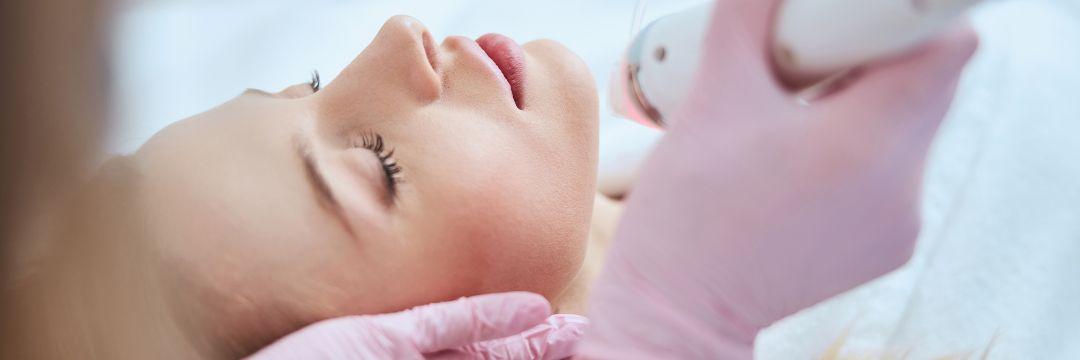Potenza RF Microneedling vs. Morpheus 8V – Is One Better?

If you’ve ever investigated skin rejuvenation treatments, you’ve likely heard of microneedling. This minimally invasive cosmetic procedure is just how it sounds — it involves using tiny needles to puncture the skin and generate a more youthful look to your facial skin.
Microneedling has been around for over a hundred years, but the procedure as we know it today was conceived in 1995 when two researchers wrote a medical journal article describing the use of needling on scars and wrinkles. The process has seen dramatic improvements since then.
When it comes to microneedling, two very popular procedures include the Morpheus8 and Potenza RF. Both methods accomplish the same outcome but in a slightly different way. Unsure about which to choose? No worries – we’ve got the lowdown on both right here…
First Things First: How Does Microneedling Work?
During a microneedling procedure, Dr. Boger uses thin needles to make tiny holes in specific areas of the topmost layers of skin. This injury stimulates your body’s production of collagen and elastin — two substances that help skin look smoother and younger. Results from microneedling are typically seen about 4 to 6 weeks after treatment.
While microneedling is most often done on the face, it can also be used on other body parts, such as areas with stretch marks or scarring. There is also evidence that microneedling can help with scalp hair loss (such as male pattern baldness).
What is Morpheus8?
Morpheus8 is a newer microneedling treatment that improves traditional techniques for more significant results. It combines bipolar radiofrequency with microneedling. The microneedling stimulates collagen production, while the radiofrequency waves penetrate about 4 millimeters deep, helping skin tighten.
During a Morpheus8 treatment, your doctor or aesthetician will apply a topical numbing cream to minimize discomfort. Then, a small handheld applicator with tiny needles is applied to the targeted area. You will feel the heat from radiofrequency waves and a series of “stamping” motions rather than a continuous roll across your skin.
Morpheus8 is suitable for improving the look of facial skin by addressing wrinkles, acne scarring, and discoloration. Another form of treatment, Morpheus8 Body, can be used in other areas to improve the appearance of cellulite, reduce fat, and tighten loose skin.
Recovery from a Morpheus8 procedure takes a few days to a few weeks. During this time, your skin may appear red or swollen. Keep your skin clean and use a gentle moisturizer until the skin is healed. You should avoid the sun and apply sunscreen with an SPF of 30 or more if you must go outside. In the weeks following treatment, you’ll see a noticeable improvement in your skin’s texture and tightness. You’ll need a few repeated treatments (anywhere from 3 to 6 sessions, spaced a few weeks apart, are generally recommended) for optimum results.
What is Potenza?
Like Morpheus8, Potenza also combines radiofrequency with microneedling. But while Morpheus8 uses bipolar RF waves, Potenza uses both monopolar and bipolar. The monopolar waves penetrate more deeply into the skin, making it a preferable treatment option for issues that lie deeper within the skin, such as cellulite. The Potenza applicator is also highly customizable, and it uses several different kinds of needle tips and output/heat settings to ensure that the treatment you receive suits your skin type and needs. This makes it especially good for people with dark skin tones, who are more likely to experience hyperpigmentation (darkening of the treatment areas).
Moreover, the Potenza applicator also has a Fusion Tip, which allows Dr. Boger to administer topical treatments deep into your skin simultaneously with the microneedling. Hyaluronic acid, platelet-rich plasma (PRP), or other anti-aging treatments can be infused into the skin with Potenza.
A Potenza session starts with cleaning your skin and numbing with a topical cream. A handheld applicator is used to administer the microneedling, during which time you may experience pinpoint bleeding. Once complete, your skin will take a few days to heal, and you should start seeing results 4 to 6 weeks later. Several repeat treatments about six weeks apart are recommended for best results.
Who Should Not Get Microneedling?
While most people can be safely treated with microneedling, some medical conditions may make microneedling a less-than-optimal choice. People with blood-clotting disorders or who take blood thinners may not be good candidates for microneedling, as the needles can cause bleeding. If you have conditions that affect your skin, like eczema or diabetes, microneedling may not be a good idea either. Finally, if you have a weakened immune system, skin cancers, or acne in the targeted areas, microneedling may not be advised. Talk with Dr. Boger about your health history and whether microneedling is a good choice.
References:
- https://pubmed.ncbi.nlm.nih.gov/7773602/
- https://pubmed.ncbi.nlm.nih.gov/34714971/
- https://pubmed.ncbi.nlm.nih.gov/7773602/
- https://www.fda.gov/consumers/consumer-updates/microneedling-devices-getting-point-benefits-risks-and-safety
- https://www.aad.org/public/cosmetic/scars-stretch-marks/microneedling-fade-scars